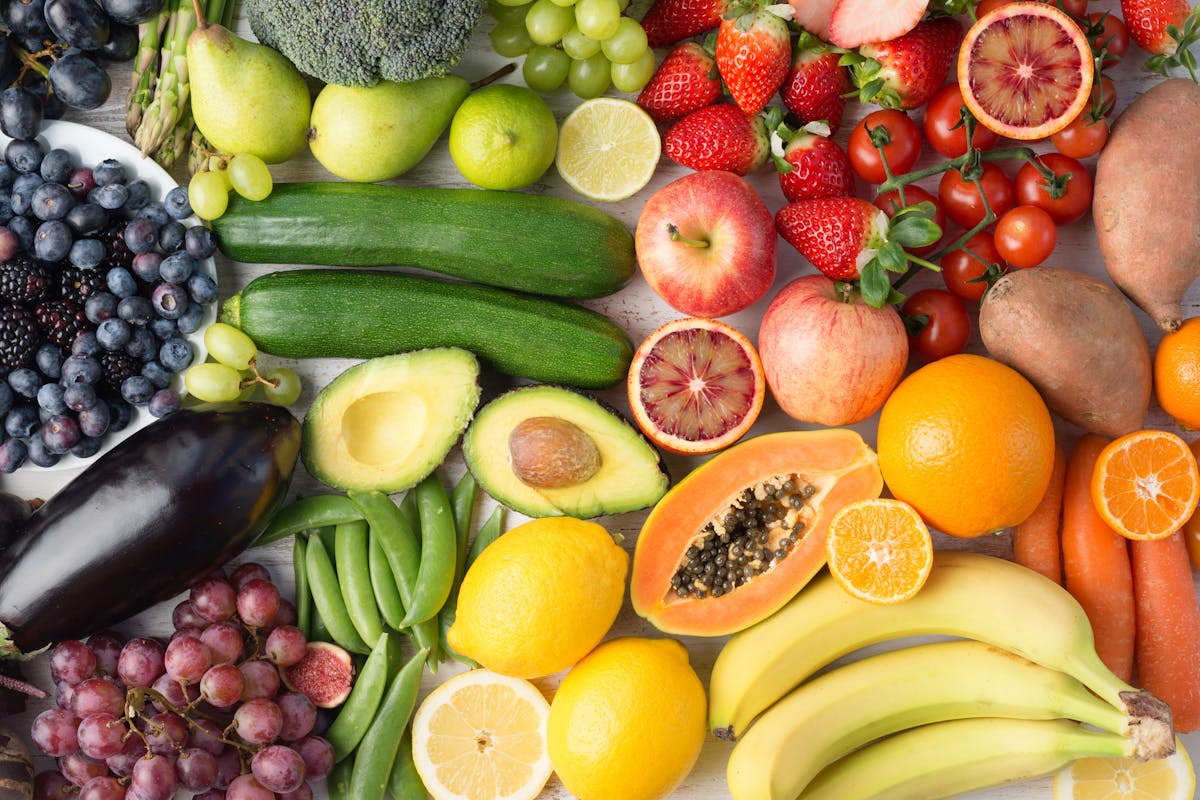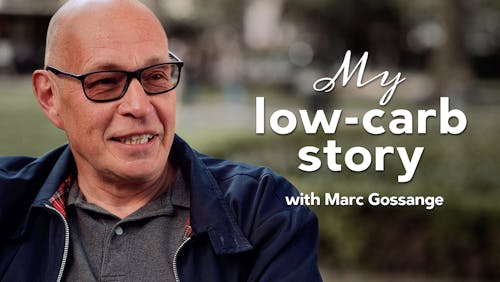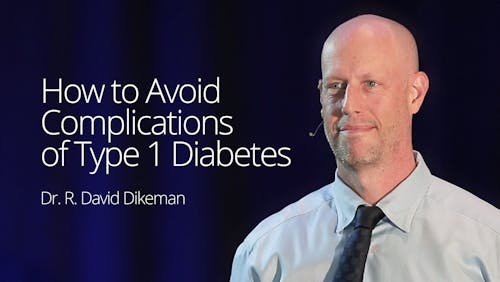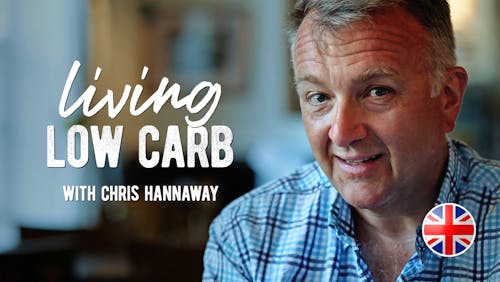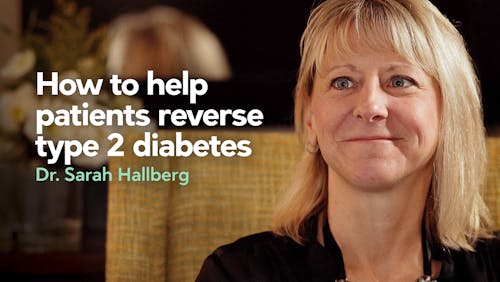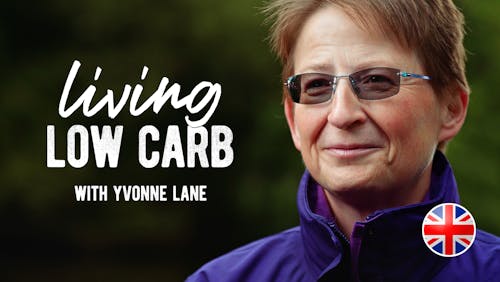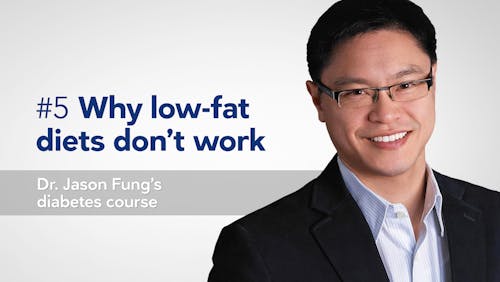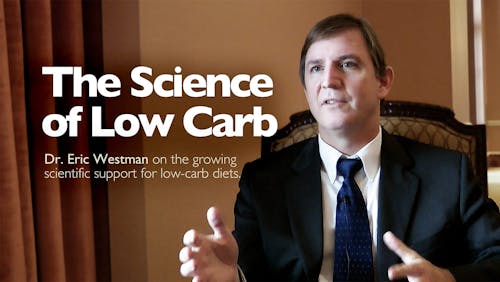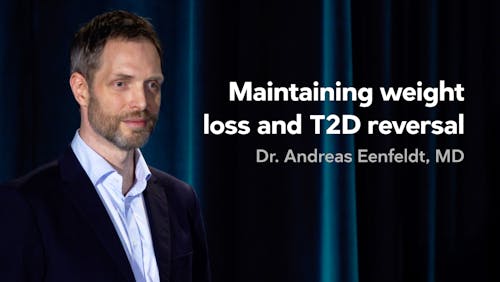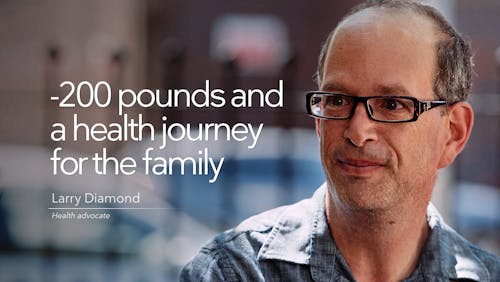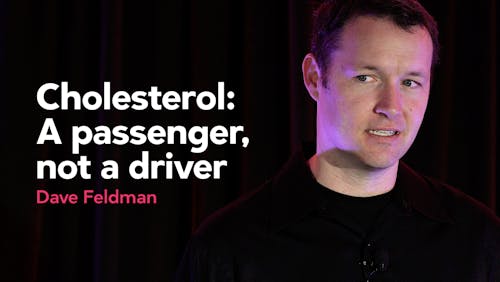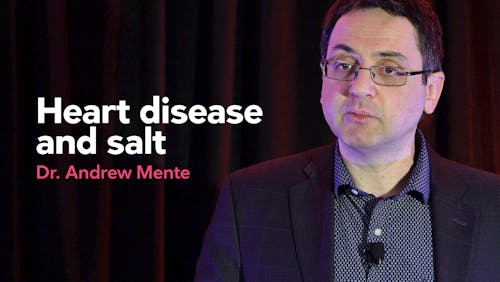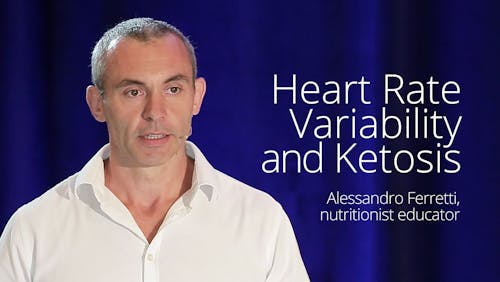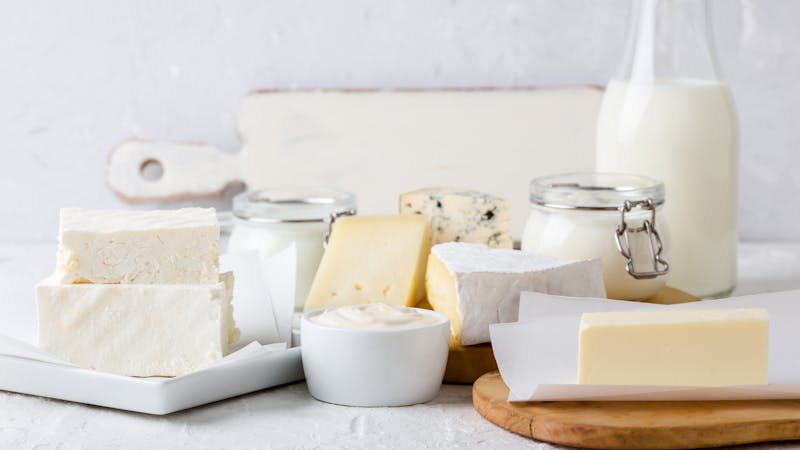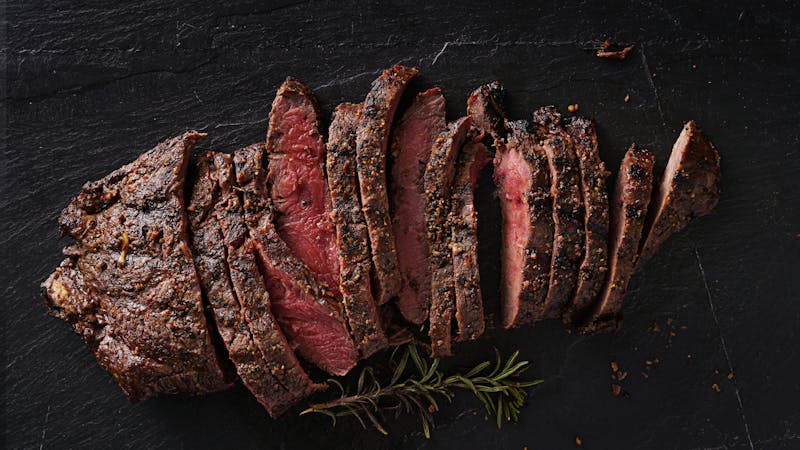Do you need to eat fruits and vegetables?
What is the role of fruits and vegetables in a healthy diet? Let’s take a closer look at this question.
Eating fruits and vegetables is often recommended to live longer, healthier lives. Observations show that healthy people who eat fruits and vegetables can consistently live into their 90’s and 100’s.1
While this type of data may show that fruits and veggies can be part of a healthy lifestyle, it doesn’t prove that people live longer specifically because they eat fruits and vegetables.
How many fruits and vegetables do we need to eat? And can we find similar benefits in other foods?
Here’s the current scientific evidence on fruits and vegetables.
1. What are fruits?
Fruits are the seed-containing portion of various flowering plants. They grow exclusively above ground.
Different types of fruit
The broad categories of fruit include pome, citrus, tropical, melons, stone fruits, and berries. Most fruits taste sweet, although citrus varieties are often sour or bitter. With the exception of bananas, most domesticated fruits are juicy due to their high water content.
Keep in mind that the fruit we have today is not the same as the fruit available to our hunter-gatherer ancestors.2
Nutritional composition of fruits
While fruit does contain fiber, antioxidants, and important vitamins like C, it also contains a fair amount of sugar – around 10% by weight (the rest is mostly water).3 Just taste an orange or a grape. Sweet, right?
Eating whole fruits in moderation – especially ones that are low in sugar, like berries – can absolutely be part of a healthy diet. The soluble fiber in fruit can help with short-term satiety; it also reacts with water in your gut to form a thick gel that helps delay and reduce the amount of sugar absorbed from that fruit. In fact, up to 30% of the sugar from fruit may not be absorbed.4
Larger quantities of fruit, however, will deliver a significant sugar load to your intestines. Even if only 70% of that sugar is absorbed, 70% of a big number is still a big number. For example, five servings of fruit per day can be equivalent to the amount of sugar in 16 ounces (500 ml) of soda – 52 grams of sugar!5
Guide What are the best and the worst fruits and berries to eat on a low-carb diet? Here’s the short version: most berries are OK low-carb foods in moderate amounts, but fruits can be seen as candy from nature (they contain quite a lot of sugar).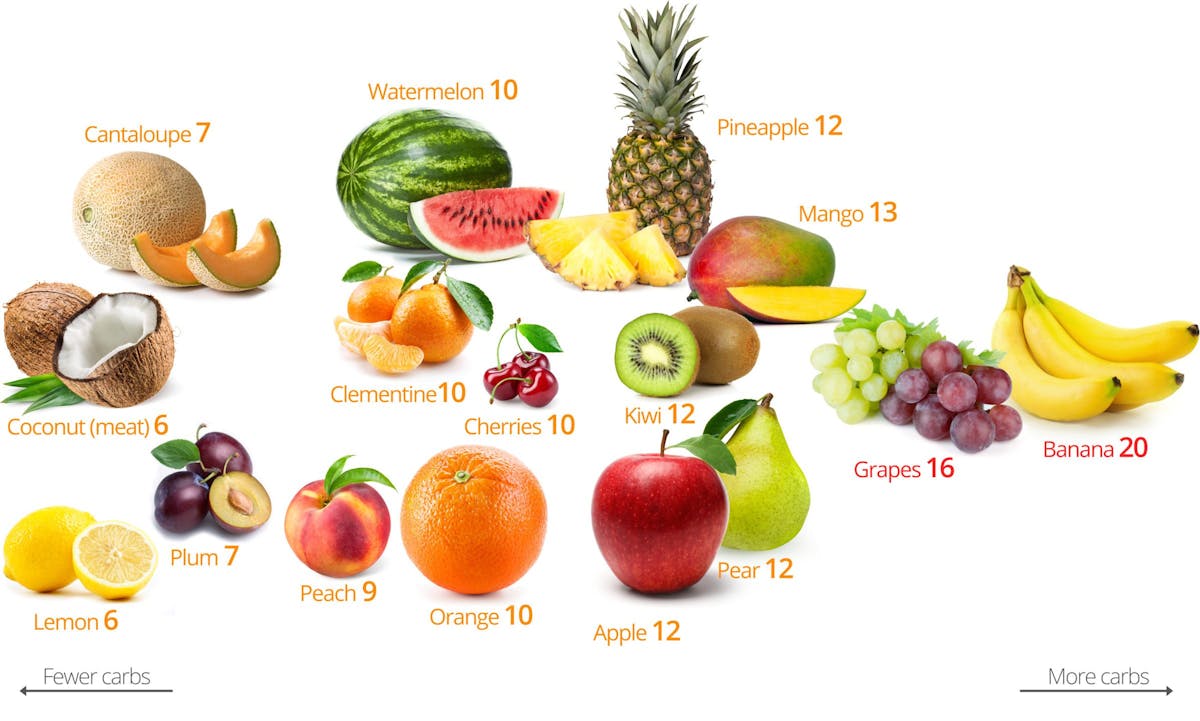
Low-carb fruits and berries – the best and the worst
2. What are vegetables?
Speaking from a botanical or gardening point of view, vegetables are the leaves, stems or roots of plants. However, many non-sweet fruits are commonly considered vegetables for eating or cooking purposes.
Different types of vegetables
Vegetables can be broadly classified into four categories:
- Above-ground vegetables: greens (spinach, lettuce, chard, et cetera), cruciferous vegetables (broccoli, brussels sprouts, cabbage, cauliflower, kale, et cetera), bulbs (onions, garlic), and fungi (mushrooms).
- Below-ground/root/starchy vegetables: beets, carrots, parsnips, rutabagas, turnips, yams, potatoes, sweet potatoes, et cetera.
- Gourds: pumpkins, hard-shelled squashes, and other winter squashes.
- Technically fruits but treated like vegetables: avocados, olives, bell peppers, eggplant, tomatoes, and zucchini. Unlike other fruits, these aren’t sweet and are often prepared and consumed with other vegetables. Avocados and olives are unique among fruits and vegetables because most of their calories come from fat rather than sugar or starch.
Nutritional composition of vegetables
Non-starchy vegetables are low-carb and keto-friendly foods that provide 5 or fewer grams of net carbs per 100-gram (3.5-ounce) serving. By contrast, root and starchy vegetables have 6 to 17 grams of net carbs per serving.
Vegetables usually contain moderate to high amounts of fiber, especially avocado — which also happens to be among the lowest in net carbs.
Overall, vegetables are more nutrient-dense than fruits, but their vitamin and mineral content can also be affected by factors like growing and storage conditions. Most veggies are good to excellent sources of potassium, and bell peppers and cruciferous vegetables are also high in vitamin C.
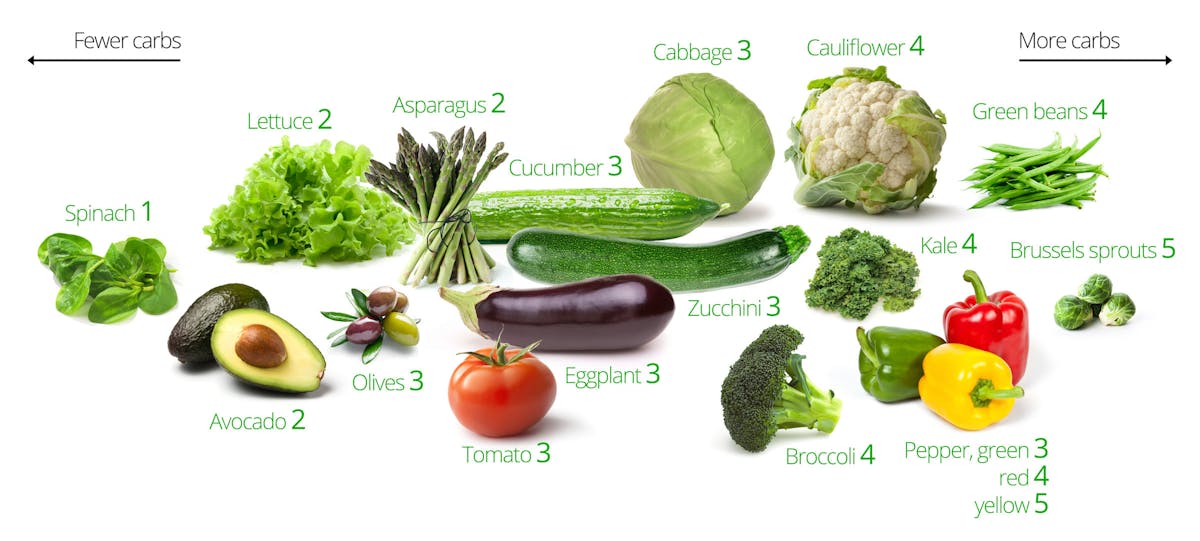
Low-carb vegetables – the best and the worst
Guide What are the best and the worst vegetables to eat on a low-carb diet? Here’s the short version: Vegetables growing above ground are usually low carb and can be eaten freely.
3. How many fruits and vegetables should people eat per day?
Looking at official recommendations for fruit and vegetable intake in different countries, it’s clear that they’re basically all variations on “5 a day.” The US dietary guidelines, the UK National Health Service, and the World Health Organization all set minimums that are generally equivalent to two cups of fruit and two and a half cups of vegetables each day.
According to the Centers for Disease Control, only 1 in 10 adults consistently meets the US Dietary Guidelines recommendations for fruit and vegetable intake.6 But is this really a problem?
Some low-carb diet experts would say no, and that it is possible to meet the needs for essential nutrients with fewer servings of fruits and vegetables.
If someone feels better or improves certain health markers by avoiding all fruits and vegetables, one might ask if it’s healthy to do this long-term. We don’t know the answer to that question, and therefore we suggest experimenting with different types of fruit and veggies to see if some are tolerable.
Although blog posts, online support groups, and growing clinical experience report improved short-term health for many people following this style of eating, there are currently no data to support this as equally healthy or better than a diet that includes plants.7
Health organizations state that their recommendations for fruit and vegetable intake are evidence-based. But as we’ve discussed previously in other guides, there are different levels of scientific evidence. And almost all these fruit and vegetable recommendations are designed for someone who is eating a standard Western diet or a low-fat, high-carb diet.8
Let’s explore the high-quality evidence available to see whether eating more fruits and vegetables has actually been proven to improve health.
4. Research on the benefits of eating fruits and vegetables
Obesity
With few exceptions, eating more fruits and vegetables is standard weight-loss advice. But if we look at the results of experimental trials in which people ate more — or at least were encouraged to eat more — of these foods, we find that the majority of studies show little to no benefit for weight loss.
A 2014 systematic review of eight randomized controlled trials (RCTs) lasting between 4 and 52 weeks found that people assigned to increase their fruit and vegetable intake lost an average of only 1.5 pounds more than those assigned to eat smaller amounts of these foods.9
The same year, researchers who published a systematic review of seven different RCTs failed to find any measurable differences in weight change between people who consumed high vs. low amounts of fresh produce.10
In other studies, people who ate more fruits and vegetables actually gained weight, presumably because they didn’t compensate by cutting back on other foods.11
On the other hand, if we focus on replacing highly-processed food with fruits and vegetables, it might lead to weight loss.
In a three-month study, overweight women who were given vouchers to purchase fresh produce lost 6 pounds, whereas those who were given vouchers to purchase any type of groceries gained 4 pounds by the study’s end.12
As we have said before, the overall diet likely matters more than individual foods.
Given that the results of most clinical trials have been disappointing when it comes to demonstrating weight loss with increased fruit and vegetable intake, what is the basis for the ubiquitous advice that this is key to achieving and maintaining a healthy weight?For decades, it’s mainly been larger yet lower-quality observational (also called epidemiological) research.
For instance, a 2015 systematic review analyzing 17 such studies found statistically weak associations between eating a lot of produce and lower body weight and waist size.13
What were the odds ratios (ORs) in this study? They were 0.83 for high intake of fruits or vegetables alone and 0.91 for high intake of fruits and vegetables combined. While these modest odds ratios could reflect a tendency of fruits and vegetables to be associated with mild weight loss, they could also be a result of healthy user bias or other confounders commonly found in epidemiological data. Even the study authors acknowledged that “The present meta-analysis seems to be limited by low study quality.”

Guide to observational vs. experimental studies
Guide In this guide, we discuss the differences between observational and experimental studies, the advantages and disadvantages of each, and why in nearly all cases observational research shouldn’t be used when making decisions about your diet.
Diabetes and metabolic syndrome
Fruits and vegetables are generally considered diabetes-friendly foods. In fact, many types of produce make the “low GI foods” list on the American Diabetes Association website. Notable exceptions include melons, pineapple, and dried fruits such as dates, raisins, and cranberries.
But how does adhering to “5 a day” or similar dietary advice affect blood sugar control and insulin resistance? The evidence from clinical trials is mixed.One systematic review of eight RCTs examining the effects of fruit and vegetable intake in people with metabolic syndrome found that, although diastolic blood pressure slightly improved in those who ate more produce, fasting blood sugar levels were no different among the groups.14
In one RCT published in Diabetes Care — a journal of the American Diabetes Association — researchers assigned overweight adults to consume two, four, or seven portions of fruits and vegetables per day for 12 weeks. Ultimately, none of the groups experienced any improvement in insulin resistance.15
However, results from another RCT found that a powder derived from broccoli sprouts lowered insulin levels and improved insulin sensitivity in adults with type 2 diabetes.16
Of course, none of the above studies specifically looked at people consuming low-carb or keto diets. It’s unknown whether adding broccoli or other green vegetables to a low-carb or keto diet would further reduce insulin resistance.17
What about lower-quality observational studies that suggest eating plenty of fruits and vegetables can help protect against type 2 diabetes? Large meta-analyses of these studies have shown very weak associations between fruit and vegetable intake and type 2 diabetes risk.18
Videos about diabetes
Heart disease
Are fruits and vegetables heart-healthy? Although some experimental research suggests that eating more produce might reduce some cardiovascular disease (CVD) risk factors, the evidence to date is inconclusive with respect to clinical outcomes.
For instance, in 2013 researchers conducted a systematic review of 10 RCTs investigating whether eating more fruits and vegetables led to improvements in heart health markers. Although individual trials didn’t show impressive results, pooling the data suggested at least some favorable effect on cardiovascular risk factors (e.g. blood pressure and cholesterol).19
Another systematic review of both intervention trials and prospective cohort studies found that high potassium intake seemed to be beneficial for the arteries, while the effects of high fruit and vegetable intake on arterial function weren’t clear.20
Some RCTs suggest that boosting produce intake may increase blood levels of antioxidants that could improve HDL function and reduce inflammation in those at high risk for CVD, such as those with diabetes.21
Yet others found no reduction in CVD risk factors in overweight people who consumed seven servings of produce per day compared to those who consumed two servings per day for 12 weeks.22
There is some suggestion of benefit in observational studies; but as usual, it is necessary to point out that this sort of nutritional epidemiology research is inherently very weak and can’t prove cause and effect.23
It’s also important to recognize that it’s very difficult to assess the effect of a single variable dietary change on the risk of something like cardiovascular disease, which can take years to develop and manifest. This is why most organizations promote a general pattern of healthy eating.24
Videos about heart disease
Cancer
“Eating lots of fruits and vegetables can help reduce your cancer risk.” This message is taken verbatim from the website of the American Cancer Society. But is there strong scientific evidence that eating large amounts of fruits and vegetables will help protect you from cancer?
Although fruits and vegetables are whole foods that contain beneficial nutrients, it’s too early to make that claim for them. In fact, it’s too early to make that claim for any foods with certainty, because very little high-quality experimental research has examined how specific foods affect cancer risk and progression.
It’s known that damage to DNA in cells may raise the risk of developing cancer in the future. One randomized cross-over study in healthy people found that consuming kiwifruit for three weeks led to increased antioxidant activity that helped repair DNA, regardless of whether small or large amounts were consumed.25
Similar results were seen in young male smokers who consumed three servings of broccoli per day for 10 days.26
However, other studies haven’t shown any improvement in DNA repair in people who increased their fruit and vegetable intake.27 And one even suggested that cruciferous vegetables may temporarily damage DNA, although this effect seems to disappear within several hours.28
Cruciferous vegetables like broccoli and cabbage contain compounds that might help reduce cancer risk in several ways, such as decreasing inflammation and improving cell signaling.30
Yet it appears there’s probably a threshold above which more of these protective compounds cannot be absorbed, so that very high intakes offer no further benefit than consuming more modest amounts.31
Many fruits and vegetables have other phytochemicals (literally “plant chemicals”) with potential anti-cancer activity, such as resveratrol and sulforaphane.32 However, their effects have been studied mainly in test tubes and animals. High-quality human research is needed before any conclusions can be made about their utility in cancer prevention or treatment.
In contrast to the limited amount of experimental research, plenty of observational studies have explored the relationship between fruit and vegetable intake and cancer risk. Researchers who conduct systematic reviews of these studies often conclude that people who eat the most fruits and vegetables decrease their risk of developing cancer.
As usual, these analyses cannot infer causality, but they reveal weak associations (RRs of 0.78 to 0.92) between eating a lot of produce and being diagnosed with any type of cancer, including breast, lung, colon, bladder, and non-Hodgkin’s lymphoma.33
In summary, eating fruits and vegetables — especially cruciferous types — may very well decrease your risk of cancer, but much more rigorous research is needed before we can say this definitively.
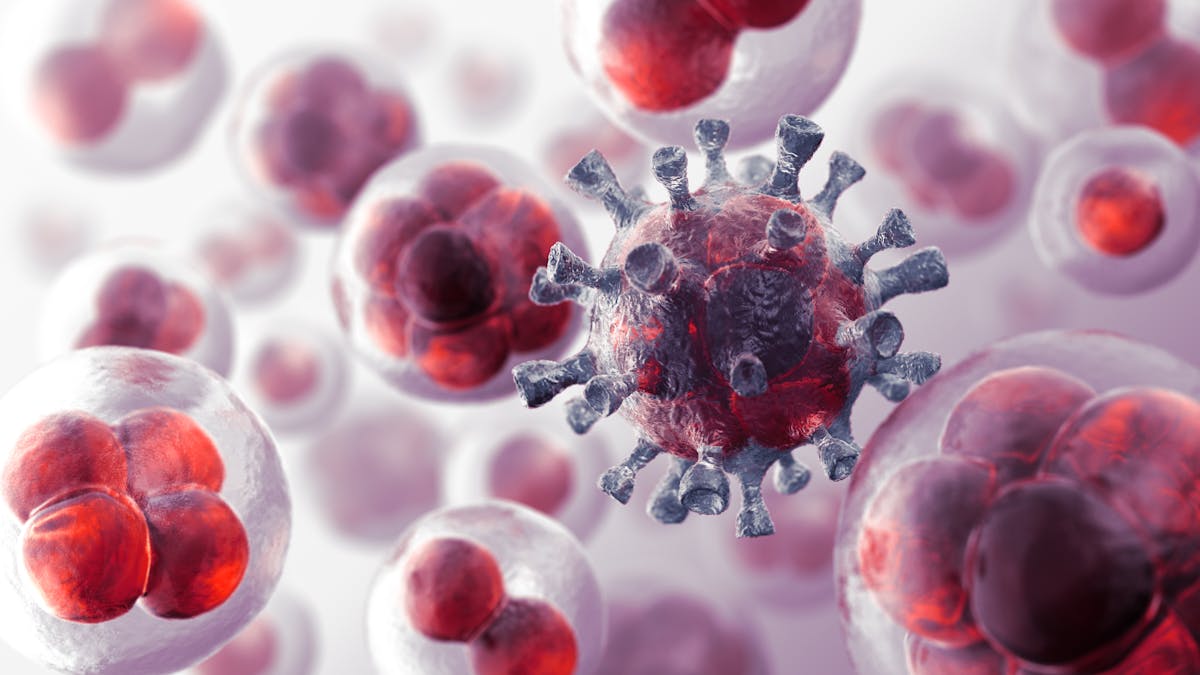
Diet and cancer: What we know and what we don’t
Guide In this guide, we’ll look at what we know — and what we don’t know — about food and cancer.
Other conditions
Nearly all research on the benefits of fruit and vegetables for other conditions is observational, but a couple of experimental studies suggest potential benefits:
- Bone health: Results from one RCT found that increasing intake of certain fruits, vegetables, and herbs may improve bone health. Postmenopausal women who ate the “Scarborough Fair” diet — which included daily servings of leafy greens, cabbage, onions, mushrooms, prunes and, of course, parsley, sage, rosemary, and thyme (remember the old Simon and Garfunkel song?) — experienced less bone breakdown and calcium loss than women who consumed their usual diets or added other types of plants to their diets.34 In addition, a meta-analysis of both observational studies and RCTs found an association between an increased intake of fruits and vegetables and a decrease in the risk of fractures.35
- Psychological health: A two-week study investigated the potential mental-health benefits of increasing fruit and vegetable intake in young adults who typically consume very little of these foods. The study participants reported improvements in well-being and motivation but no changes in depressive symptoms or overall mood.36
5. Can eating fruits and vegetables cause health problems in some people?
Most of us can eat a moderate portion of vegetables without any problems. Because they’re higher in sugar, fruits are generally best enjoyed in smaller quantities. However, for some people, both fruits and vegetables may cause issues.
Although there isn’t much published research about sensitivities to specific compounds found in fruits and vegetables, it is possible a small minority of people may have an unpleasant reaction to fruits and vegetables. This might be related to:
- Salicylates: Salicylates are found naturally in some fruits and vegetables.37 Fruits and vegetables high in salicylates include berries, oranges, pineapples, apricots, broccoli, cucumbers, and zucchini.
- Oxalate: People who suffer from oxalate-containing kidney stones may have an increased frequency of stone formation if they over-consume fruits and vegetables high in oxalate.38 Spinach contains much more oxalate than any other vegetable, but rhubarb, beet greens, kale, and other leafy greens also contain large amounts.
- Histamines: Your body releases histamine on its own as part of an immune response, but in rare conditions people can have excessive levels or an inability to break it down, and histamine can cause symptoms like hives, abdominal pain, asthma, and headaches.39 High-histamine foods include eggplant, spinach, tomatoes, sauerkraut, and avocados.
- FODMAPS: This is an acronym for fermentable oligosaccharides, disaccharides, monosaccharides and polyols. These sugar molecules — found most often in fruits, vegetables and grains — can cause digestive upset in people with irritable bowel syndrome (IBS). People with IBS often find reducing or eliminating FODMAP foods greatly improves their symptoms.40
If you suspect you may have one of these sensitivities, keep in mind that processed, canned, and fermented foods also contain some of these compounds. Your symptoms might also be due to another health issue. Be sure to see a doctor for a full work-up to rule out other causes.

6. Will avoiding fruits and vegetables lead to nutrient deficiencies?
Many people feel that fruits and vegetables are indispensable for health because they provide important vitamins and minerals. While it’s true that they contain several micronutrients and phytonutrients which could play important roles in the maintenance of good health, it’s important to recognize other minimally processed foods can help meet your needs.
Meat, fish, eggs, and dairy provide many essential vitamins and minerals. For example, dairy is a great source of potassium and magnesium. Organ meats like chicken liver and beef kidney are good sources of vitamin C.41 Hence, eating a varied, low-carb diet – with a mix of low-carb fruits and vegetables – will help you meet your nutrient needs for vitamin C, potassium, folate, and other key nutrients.
What about fiber? Although fiber isn’t an essential nutrient, many health organizations recommend a daily minimum of 25 grams per day for adults.
Some believe that low-carb diets are inherently low in fiber. But that simply is not true. Nuts and seeds, avocado, berries, coconut, and many non-starchy veggies are all high-fiber foods you can enjoy on a low-carb diet.
You can read more about the science behind fiber intake in our guide on whole grains.
7. Summary – fruits and vegetables: optional, optimal, or essential?
Fruits and vegetables are whole foods that provide vitamins, minerals, and fiber, along with other potentially beneficial compounds like phytonutrients.
In addition, many people — although certainly not all — genuinely enjoy the taste and texture of low-carb fruit and veggies, especially when combined with a fat or tasty sauce. Think creamed spinach, zucchini noodles fettuccine with olive oil and butter, or berries with cream.
Moreover, there’s no question that replacing high-carb processed foods with fresh fruits and vegetables is a healthy move. And above-ground vegetables can play an important role in higher satiety eating.
It is possible – though not definitively proven – that fruits and vegetables play an independent role in reducing disease risk. In the case of cruciferous and leafy green vegetables, it seems likely.
As always, we advise considering fruits and vegetables in the context of your whole diet. If you find that following a low-carb diet helps you lose body fat and get your diabetes or prediabetes under control, this is what will have the greatest impact on your overall health. With this strategy, you can still eat a variety of low-carb vegetables and some fruits to obtain the potential benefits.
Start your FREE 7-day trial!
Get instant access to healthy low-carb and keto meal plans, fast and easy recipes, weight loss advice from medical experts, and so much more. A healthier life starts now with your free trial!
Start FREE trial!Do you need to eat fruits and vegetables? - the evidence
This guide is written by Franziska Spritzler, RD and was last updated on June 19, 2025. It was medically reviewed by Dr. Michael Tamber, MD on September 14, 2021 and Dr. Bret Scher, MD on September 25, 2022.
The guide contains scientific references. You can find these in the notes throughout the text, and click the links to read the peer-reviewed scientific papers. When appropriate we include a grading of the strength of the evidence, with a link to our policy on this. Our evidence-based guides are updated at least once per year to reflect and reference the latest science on the topic.
All our evidence-based health guides are written or reviewed by medical doctors who are experts on the topic. To stay unbiased we show no ads, sell no physical products, and take no money from the industry. We're fully funded by the people, via an optional membership. Most information at Diet Doctor is free forever.
Read more about our policies and work with evidence-based guides, nutritional controversies, our editorial team, and our medical review board.
Should you find any inaccuracy in this guide, please email andreas@dietdoctor.com.
These observations were made in the so-called “Blue Zones,” areas where people live into their 90’s and 100’s much more often than the world-wide population.
However, these were not results from a scientific study. Plus, these individuals are typically thin, routinely physically active, eat fewer calories than the general population, eat mostly home-prepared local ingredients, and have other healthy lifestyle habits. ↩
Looking back at the diets of our hunter-gatherer ancestors, it’s clear that humans have been consuming plants (along with animals) for over a million years. Roots, leaves, berries and other fruits were readily eaten, but always based on seasonal availability.
American Journal of Clinical Nutrition 2000: Plant-animal subsistence ratios and macronutrient energy estimations in worldwide hunter-gatherer diets [overview article; ungraded]
Today, a quick trip to the grocery store can present us with hundreds of produce options 365 days a year — many of them larger and more visually appealing than ever due to advanced farming methods and hybridization. Some domesticated fruits have become much bigger and less bitter compared to their earlier counterparts, and most have smaller seeds, thinner peels, and a higher water content, making them easier to eat:
Diet Doctor: What fruits looked like before we domesticated them
Journal of Experimental Botany 2014: The fruit, the whole fruit, and everything about the fruit [overview article; ungraded] ↩
The following US government source shows the sugar content of many different types of fruit:
US Food and Drug Administration 2017: Raw Fruits Poster [overview article; ungraded] ↩
Nutrients 2016: Paradoxical Effects of Fruit on Obesity[overview article; ungraded] ↩
This depends to some extent on the type of fruit; for instance, berries are much lower in sugar than oranges, pineapple, bananas, and most other fruits. If someone eats 1 apple, 1 banana and 1/4 cantaloupe, the total sugar load of 55 grams will have already surpassed the sugar in one large Coke. ↩
Morbidity and Mortality Weekly Report 2017: Disparities in state-specific adult fruit and vegetable consumption — United States, 2015 [overview article; ungraded] ↩
We are encouraged that some in the carnivore community are putting together studies to try to answer these questions and improve the quality of data regarding a diet without plant matter. ↩
We are not aware of any studies examining the RDA of fruits and vegetables in the setting of a low-carb or keto diet. ↩
BMC Public Health 2014: Systematic review and meta-analysis of the effect of increased vegetable and fruit consumption on body weight and energy intake [strong evidence] ↩
However, the interventions differed among the RCTs included in both this analysis and the one cited in the preceding paragraph. In some cases, people were provided with fresh fruits and vegetables or vouchers to purchase them; in others, they only received advice to consume more of a specific fruit or vegetable.
Furthermore, in most of these studies, researchers relied on reported produce intake from the groups rather than closely monitoring their intake. It often simply wasn’t clear whether people ate their assigned amounts of fruits and vegetables. Additionally, the average amounts consumed were only 1.5 portions/day, potentially making it difficult to detect between-group differences.
American Journal of Clinical Nutrition 2014: Increased fruit and vegetable intake has no discernible effect on weight loss: a systematic review and meta-analysis [strong evidence] ↩
For instance, in one RCT, when overweight and obese people were provided with fresh fruits and vegetables to add to their diets for eight weeks, they gained twice as much weight as lean participants, who responded to increased produce intake by eating less of other foods. But all three groups gained weight after consuming the same amount of produce in juice form during a second eight-week period. Still, obese participants gained the most.
This also illustrates the point that it is better to eat fruits and vegetables than to drink them.
Obesity (Silver Spring) 2012: Beverage vs. solid fruits and vegetables: effects on energy intake and body weight [randomized trial; moderate evidence] ↩
Health Promotion Practice 2011: Pass the fruits and vegetables! A community-university-industry partnership promotes weight loss in African American women [randomized trial; moderate evidence] ↩
PloS One 2015: Fruit and vegetable consumption and changes in anthropometric variables in adult populations: a systematic review and meta-analysis of prospective cohort studies [observational cohort study with ORs < 2; very weak evidence] ↩
There was also no difference in waist circumference, triglycerides or HDL cholesterol levels — all of which can be used as markers of insulin resistance.
International Journal of Food Sciences and Nutrition 2015: Effect of fruits and vegetables on metabolic syndrome: a systematic review and meta-analysis of randomized controlled trials [strong evidence]
World Journal of Diabetes 2010: Surrogate markers of insulin resistance: A review [overview article; ungraded] ↩
Diabetes Care 2013: Dose-response effect of fruit and vegetables on insulin resistance in people at high risk of cardiovascular disease: a randomized controlled trial [moderate evidence] ↩
International Journal of Food Sciences and Nutrition 2012: Effect of broccoli sprouts on insulin resistance in type 2 diabetic patients: a randomized double-blind clinical trial [moderate evidence] ↩
Since low-carb diets by definition eliminate two major offenders that play a role in insulin resistance — sugar and other high-carb foods — the benefit may already be maximal and may not increase by adding vegetables. Controlled trials exploring this would need to be done. ↩
In one meta analysis, they found green leafy veggies, yellow veggies, cruciferous veggies and blueberries all had weak associations with reduced diabetes risk, with RRs between 0.72 and 0.93:
Journal of Diabetes Investigation 2016: Higher intake of fruits, vegetables or their fiber reduces the risk of type 2 diabetes: a meta-analysis [observational study; very weak evidence]
In another meta analysis, fruit and vegetable intake combined had a very low association with reduced diabetes risk (RR of 0.93), but when taken individually, vegetable intake was statistically significant while fruit intake was not:
BMJ Open 2014: Fruit and vegetable intake and risk of type 2 diabetes mellitus: meta-analysis of prospective cohort studies [observational study; very weak evidence]
Finally, this meta analysis showed no overall association between fruit and vegetable intake and risk of DM, but when separated, the data did start to show weak associations:
European Journal of Clinical Nutrition 2017: Fruit and vegetable intake and risk of incident of type 2 diabetes: results from the consortium on health and ageing network of cohorts in Europe and the United States (CHANCES) [observational study; very weak evidence] ↩
The authors reported that the trial designs differed significantly and often included other nutrition and lifestyle interventions that may have contributed to any observed beneficial effects on CVD risk.
Cochrane Database of Systematic Reviews 2013: Increased consumption of fruit and vegetables for the primary prevention of cardiovascular diseases [systematic review of randomized trials; strong evidence] ↩
Nutrition, Metabolism and Cardiovascular Diseases 2015: A systematic review of vascular and endothelial function: effects of fruit, vegetable and potassium intake [moderate evidence]
If you are interested in boosting your potassium intake, foods such as avocados, mushrooms, spinach, and broccoli are good sources of potassium.
↩Cardiovascular Diabetology 2014: A randomised controlled trial of increasing fruit and vegetable intake and how this influences the carotenoid concentration and activities of PON-1 and LCAT in HDL from subjects with type 2 diabetes [moderate evidence]
American Journal of Clinical Nutrition 2014: Flavonoid-rich fruit and vegetables improve microvascular reactivity and inflammatory status in men at risk of cardiovascular disease–FLAVURS: a randomized controlled trial [moderate evidence] ↩
In these studies, blood levels of lutein (an antioxidant found in vegetables) were measured to confirm compliance among the different groups.
Journal of Nutrition 2015: Increasing fruit and vegetable intake has no dose-response effect on conventional cardiovascular risk factors in overweight adults at high risk of developing cardiovascular disease [randomized trial; moderate evidence]
Nutrition, Metabolism and Cardiovascular Diseases 2016: Increasing fruit and vegetable intake has no effect on retinal vessel caliber in adults at high risk of developing cardiovascular disease [randomized trial; moderate evidence] ↩
For example, a large 2017 meta-analysis of 95 studies reported an 8 percent reduction (RR of 0.92) in CVD risk for every 200 grams of fruits and vegetables people reported consuming per day, up to a maximum of 800 grams per day (roughly 10 servings). This means that someone eating 10 servings per day could potentially see a 32% lower risk of a cardiovascular event.
Although a 32% risk reduction sounds impressive, it’s worth remembering that these type of data are often confounded by the fact that most people eating 10 servings of produce daily probably also engage in other habits known to protect heart health, such as working out regularly and avoiding junk food, excessive alcohol consumption, and smoking.
International Journal of Epidemiology 2017: Fruit and vegetable intake and the risk of cardiovascular disease, total cancer and all-cause mortality-a systematic review and dose-response meta-analysis of prospective studies [observational study; very weak evidence] ↩
You can think of the way organizations make dietary recommendations as a kind of “precautionary principle.” The thinking goes something like this: since fruits and vegetables 1) might help prevent CVD; 2) are also good sources of key micronutrients including folate and potassium; and 3) provide different fibers which are associated with a “healthy” gut microbiome, organizations promote their consumption.
But, as we have seen, the evidence linking the above statements to a reduced risk of hard outcomes is not particularly strong.
Is it possible that you can greatly decrease your risk of heart disease solely by eating 10 servings of fruits and vegetables every day? We simply don’t have the data to answer this question, and observational studies certainly cannot answer the question with precision.
For people who want to consume a low-carbohydrate diet, the best advice we can give is to rely on the “precautionary principle” in a way that works for you. For many people this would mean avoiding higher-carb fruits and starchy vegetables and incorporating low-carb, plant-based foods into the diet – from spinach to mushrooms to nuts and seeds to avocados. ↩
Carcinogenesis 2003: Nutritional modulation of DNA repair in a human intervention study [randomized trial; moderate evidence] ↩
Mutagenesis 2010: DNA damage and repair activity after broccoli intake in young healthy smokers [randomized trial; moderate evidence] ↩
European Journal of Nutrition 2018: Effect of increasing fruit and vegetable intake by dietary intervention on nutritional biomarkers and attitudes to dietary change: a randomised trial [moderate evidence]
Cancer, Epidemiology, Biomarkers and Prevention 2003: No effect of 600 grams fruit and vegetables per day on oxidative DNA damage and repair in healthy nonsmokers [randomized trial; moderate evidence] ↩
Journal of Nutritional Biochemistry: Assessment of DNA damage and repair in adults consuming allyl isothiocyanate or Brassica vegetables [randomized trial; moderate evidence] ↩
Cellular Physiology and Biochemistry 2017: Antioxidants maintain cellular redox homeostasis by elimination of reactive oxygen species [overview article; ungraded] ↩
Nutrition and Cancer 2009: Effect of broccoli intake on markers related to oxidative stress and cancer risk in healthy smokers and nonsmokers [randomized trial; moderate evidence]
PloS One 2008: Broccoli consumption interacts with GSTM1 to perturb oncogenic signaling pathways in the prostate [randomized trial; moderate evidence] ↩
Cancer Prevention Research 2016: Harnessing the power of cruciferous vegetables: Developing a biomarker for brassica vegetable consumption using urinary 3,3′-diindolylmethane [randomized trial; moderate evidence] ↩
Anticancer Agents in Medicinal Chemistry 2012: Plants vs. cancer: a review on natural phytochemicals in preventing and treating cancers and their druggability [overview article; ungraded] ↩
Breast Cancer Research and Treatment 2012: Fruits, vegetables and breast cancer risk: a systematic review and meta-analysis of prospective studies [observational study; very weak evidence]
Annals of Oncology 2016: Fruits, vegetables and lung cancer risk: a systematic review and meta-analysis [observational study; very weak evidence]
Journal of the National Cancer Institute 2007: Fruits, vegetables, and colon cancer risk in a pooled analysis of 14 cohort studies [observational study; very weak evidence]
Cancer Medicine 2015: Fruits, vegetables, and bladder cancer risk: a systematic review and meta-analysis [observational study; very weak evidence]
International Journal of Cancer 2013: Fruits and vegetables consumption and risk of non-Hodgkin’s lymphoma: a meta-analysis of observational studies [observational study; very weak evidence] ↩
Nutrients 2015: Increased intake of selected vegetables, herbs and fruit may reduce bone turnover in post-menopausal women [randomized trial; moderate evidence] ↩
PLoS One 2019: Fruit and vegetable intake and bones: A systematic review and meta-analysis [Systemic review of RCTs and Cohort studies combined; moderate evidence] ↩
PloS One 2017: Let them eat fruit! The effect of fruit and vegetable consumption on psychological well-being in young adults: A randomized controlled trial [moderate evidence] ↩
Deutsches Ärzteblatt International 2008: Salicylate intolerance: pathophysiology, clinical spectrum, diagnosis and treatment [overview article, ungraded] ↩
American Journal of Physiology: Renal Physiology 2019: Dietary oxalate and kidney stone formation [overview article; ungraded] ↩
Foods 2018: Biogenic amines in plant-origin foods: Are they frequently underestimated in low-histamine diets? [overview article; ungraded] ↩
Nutrition 2018: Low fermentable, oligo-, di-, mono-saccharides and polyol diet in the treatment of irritable bowel syndrome: A systematic review and meta-analysis [strong evidence] ↩
But bear in mind liver is also a very rich source of vitamin A – and a single serving contains twice the “upper tolerable limit” for vitamin A. Vitamin A toxicity is very rare and usually occurs following a rapid and acute increase in vitamin A intake. So this is why eating a variety of foods to get your vitamin C is a good idea.
One interesting hypothesis is that people who eat very-low-carb diets might need less vitamin C because glucose competes for uptake into cells with vitamin C (glucose and vitamin C are carried by some of the same transporters). At this point, the idea is based on the knowledge that certain receptors transport both glucose and vitamin C; there are no clinical data suggesting that there is any impact on vitamin C transport when glucose levels are high or low.
Journal of Physiology 2008: Vitamin C transporters [overview article; ungraded] ↩
